Media • Music • Photography • Social Good

September 2, 2012
It’s Smart to Use a Crash Test Dummy
Before I say anything else let’s just watch a crash test dummy in action. Here’s one stoically enduring its task for General Motors some time in the 1960s.
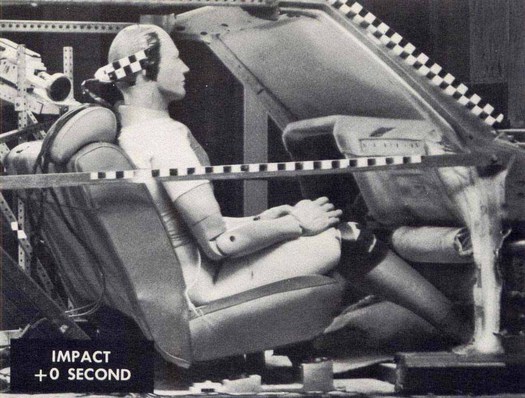
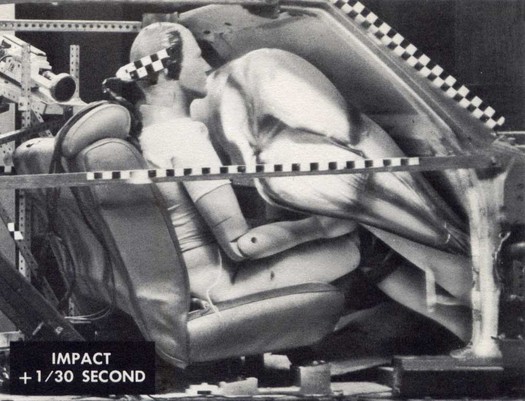

Photographs: General Motors
Maybe this kind of image leaves you cold. If so, this post might strike you as weird, pointless, even creepy. But there are plenty of crash test dummy aficionados out there, I’m quite sure of that. This one’s for all of you.
I know where my own interest in these mechanical scapegoats of the technological era began. I featured the 7-inch record cover below by The Normal way back on Design Observer in a piece about post-punk single sleeves. We can show pictures bigger now, so here it is again.

“T.V.O.D./Warm Leatherette” by The Normal, Mute, 1978. Photograph: Motor Industry Research Association
I shared the Surrealists’ fascination with the uncanny demeanor and mysteriously lifelike presence of shop window mannequins, old dolls with perfectly smooth porcelain features, wax anatomical models, and ingenious, antiquated forms of automata. Crash test dummies came under the same general heading, with an extra frisson of technology, speed, and post-war “good life” abundance pierced by the danger and violence of the car crash (there is no better handbook than this). It was the picture on the cover of “T.V.O.D./Warm Leatherette,” The Normal’s viciously dark electronic single, that fully conveyed to me (at an impressionable age) the humanoid strangeness of these sacrificial test drivers. The casual clothes strike a surely unnecessary note of realism, and there is something almost heroic about their flailing limbs and implacable calm coldly fixed by the photo in the early microseconds of destructive impact.
Actually, there’s a topical reason for returning to this subject now. The Slovenian band Laibach — more on this remarkable group some other time, perhaps — has just released an album of cover versions that includes its rendition, in minatory German, of “Warm Leatherette,” which translates neatly as “Warme Lederhaut.” The song, delivered in Laibach’s usual growling, leaden, storm-trooper vocals, is accompanied by a video by Ian Forsyth and Jane Pollard constructed, with curatorial relish for their subject, from luscious monochrome archive footage of crash test dummies giving everything thing they have for the cause of American automotive safety.
“Warme Lederhaut” by Laibach, Mute, 2012. Video by Ian Forsyth and Jane Pollard
(Love that guy with the cigarette jammed in his mouth adjusting the clump of cables.)
J.G. Ballard has a way of reappearing in this blog and it’s impossible to discuss this subject without mentioning him. “Warm Leatherette” was written in response to his 1973 novel Crash and the homage’s knowingly selected cover photo, which could hardly be improved upon, if you know the song, had the effect of stamping the crash test dummy as a definitively Ballardian persona, image and trope. British and American post-punk and industrial musicians were often avid readers of Ballard. The three pictures of the dummy with the air bag, shown above, come from It’s Smart to Use a Dummy by Suzanne Hilton published in 1971 by the Westminster Press in Philadelphia. The curator friend who lent me the book pointed out that he had first seen it mentioned in a list of references cited by the electronic band Cabaret Voltaire (Ballard readers and contemporaries of The Normal), which was published in Re/Search’s Industrial Culture Handbook (1983).
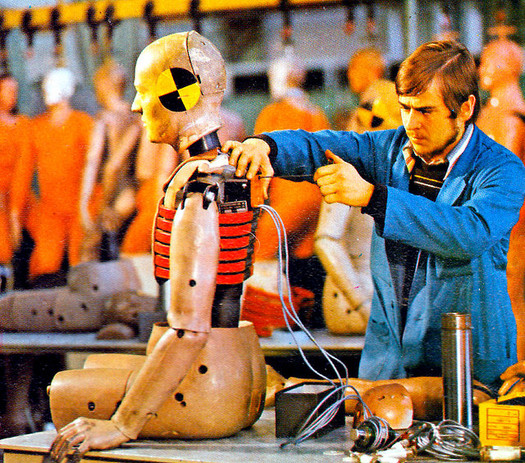
Early 1970s crash test dummy. Source: Flickr
What might once have been a recherché, if not a perverse taste — in Laibach’s rearview-mirror retelling it still looks and sounds hair-raisingly obsessive — has been thoroughly democratized by the Internet. Crash test dummies are lying about all over the place now. The wire-stuffed yellow articulated bipeds, with the circular measurement markings stuck to their domes, have become “iconic.” Never mind those unique Ballardian “ciphers of violence and desire,” these human surrogates are almost figures of dopey fun. In popular culture, they can act as obliging, depersonalized flexi-toys used to “crash test” sex positions in the pages Maxim magazine — another small but graphic sign that Ballard’s fictional extrapolations of technology and pornography, mooted 30 years earlier, were on the right track.
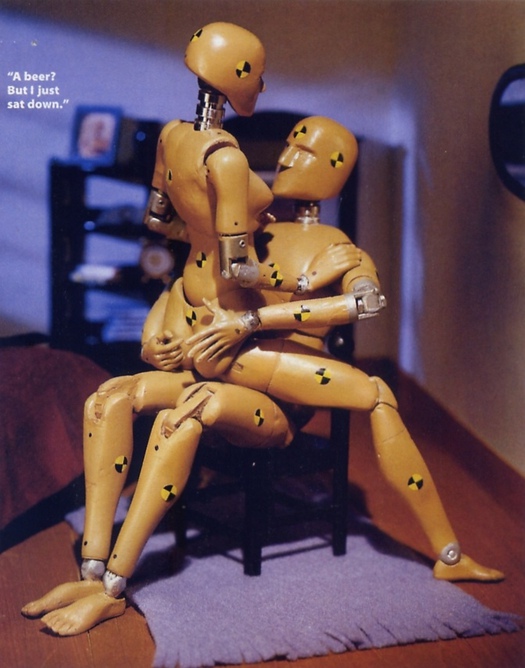
Illustration, one of a series, from Maxim, July 2001. Photograph: Satoshi. Prop styling: Mary Arch

Unused cover design for Crash by Henry Sene Yee, date unknown. Illustration: Stanley Martucci
The contemporary descendants of Sierra Sam, the first of the 1950s industrial test pioneers (his particular calling was ejection seats), are “anthropomorphic,” expertly sculpted, supersensitive pieces of advanced monitoring technology; they look more like sleek, featureless robots from an overdetermined, Spielbergian sci-fi fantasy than the old idea of a grungily improvised workshop “dummy.”
Two of the most celebrated early crash test dummies can be visited at the Science Museum in London at the far end of the temple-like Making the Modern World gallery, in a cabinet titled “The Age of Ambivalence, 1960-2000.” This Madonna and Child of the ring roads and underpasses (as Ballard might have styled it) saw active service around 1970 in tests conducted by the Motor Industry Research Association. As I have seen in the gallery, and as the many photos of the duo on Flickr confirm, these battered martyrs of the car age magnetize visitors. The hairless, jointed female has mottled skin and the child’s body is streaked with red paint, its shiny head an alarming vermilion bulb. Many pictures show the pair from above, making the dummies look tormented and abject. In some photos, there are folded cloths under the child and petri dishes at its feet; I read somewhere that it had been oozing liquid as though its abrasions were weeping stigmata. A Brompton folding bicycle suspended above them in the display throws odd, unsettling shadows. In 2007, the Science Museum dummies appeared on the cover of a poetry book, Revolt of the Crash-Test Dummies. In the best picture of all, a photographer called Arcimboldi has teleported them from their glass resting chamber and cast them into an infernal red night.
Yet seen from below in my photo, these collision-worn crash test survivors look almost serene.
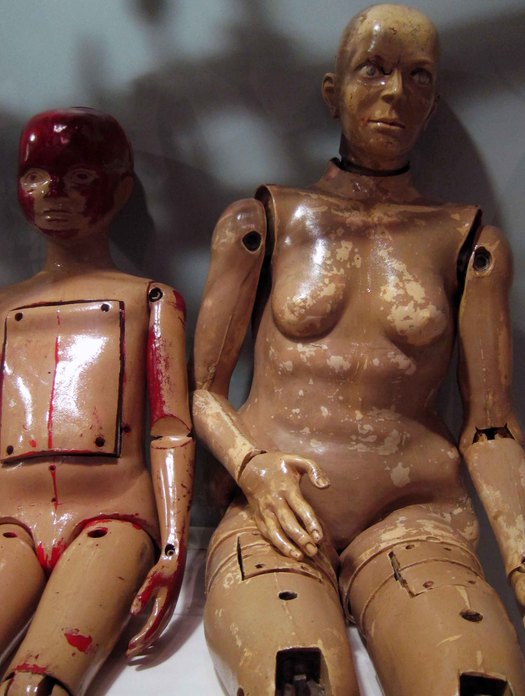
Crash test dummies at the Science Museum, London, 2012. Photograph: Rick Poynor
With thanks to Hilary Young
Observed
View all
Observed
By Rick Poynor
Related Posts
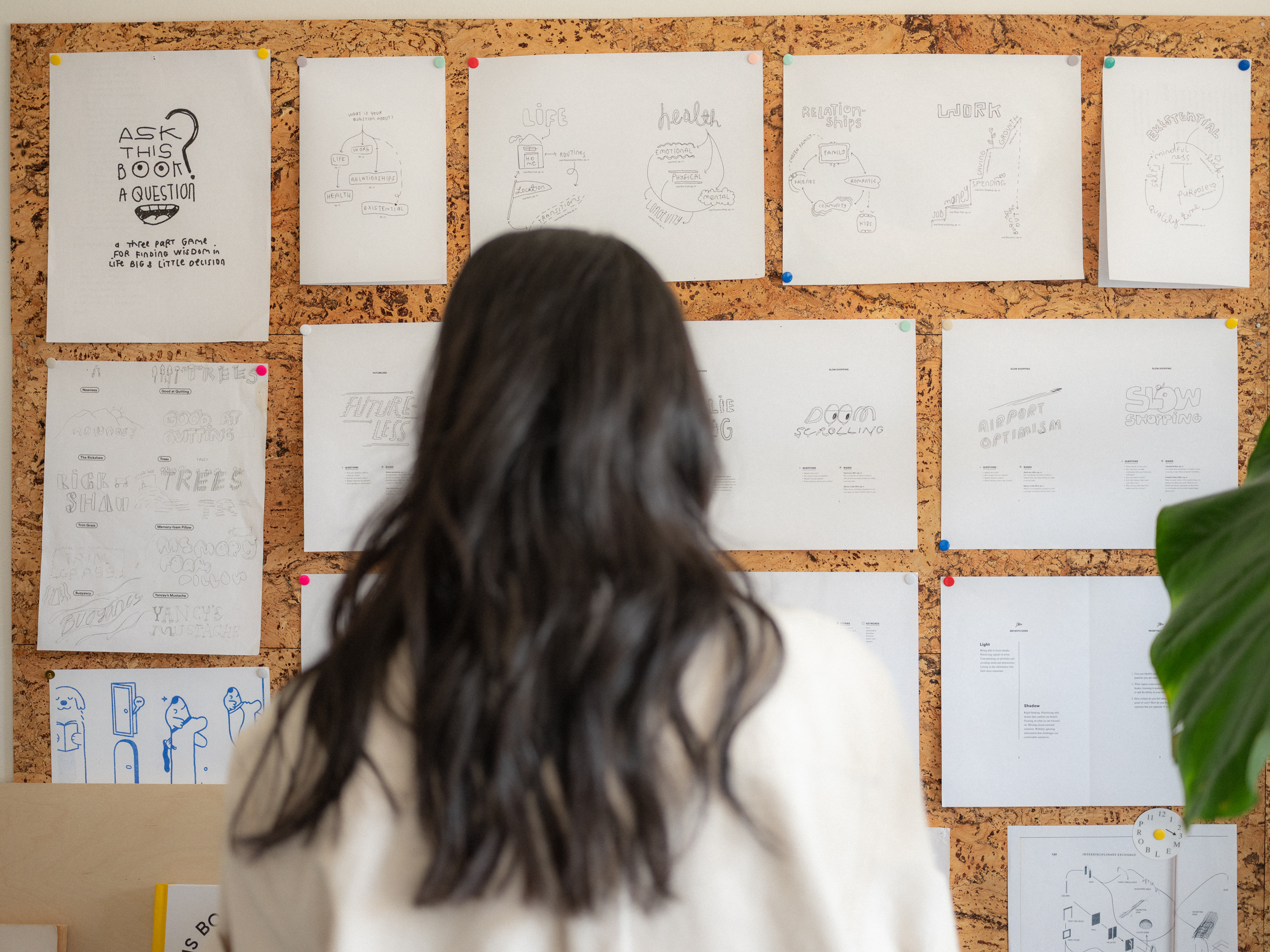
Innovation
Vicki Tan|Books
How can I design at a time like this?

Civic Life
Bert de Muynck|Essays
Walkie talkie: An architect-turned-tour guide on designing presence in Lisbon

Business
Courtney L. McCluney, PhD|Essays
Rest as reparations: reimagining how we invest in Black women entrepreneurs

Design Impact
Seher Anand|Essays
Food branding without borders: chai, culture, and the politics of packaging
Related Posts

Innovation
Vicki Tan|Books
How can I design at a time like this?

Civic Life
Bert de Muynck|Essays
Walkie talkie: An architect-turned-tour guide on designing presence in Lisbon

Business
Courtney L. McCluney, PhD|Essays
Rest as reparations: reimagining how we invest in Black women entrepreneurs

Design Impact
Seher Anand|Essays

 Rick Poynor is a writer, critic, lecturer and curator, specialising in design, media, photography and visual culture. He founded Eye, co-founded Design Observer, and contributes columns to Eye and Print. His latest book is Uncanny: Surrealism and Graphic Design.
Rick Poynor is a writer, critic, lecturer and curator, specialising in design, media, photography and visual culture. He founded Eye, co-founded Design Observer, and contributes columns to Eye and Print. His latest book is Uncanny: Surrealism and Graphic Design.